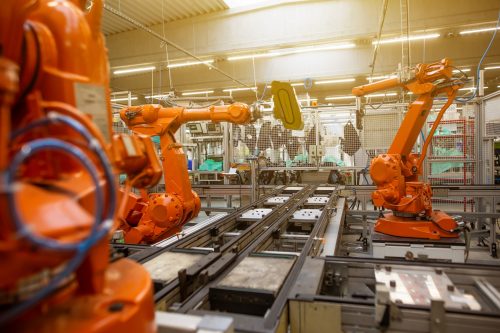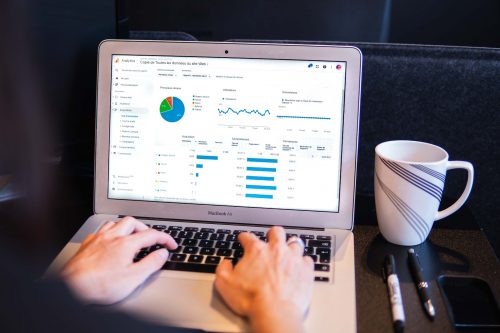October 10th 2023
Technology has been integrated so much into our lives nowadays, that it’s almost impossible to imagine our lives without it. This reliance on tech, coupled with an ever-growing need for production, makes it easy to understand why offices are upping their game when it comes to incorporating as many systems as possible to their spaces.
Today, we’re going to look at the profound significance of office technology in modern times, and how it’s only going to develop further in years to come.
But first, how did office technology get to this point in the first place?
A Short History of Office Technology and Design
It took a fair few decades to get to where we are now with office technologies. Each decade since the 80s saw huge advancements in tech which allowed us to work faster and smarter.
Let’s take a brief look at how we got here.
Late 20th Century: Advent of the Personal Computer
The late 20th century brought about what many would call the greatest innovation in office work in history, the personal computer. While paper-based systems were still being used, the desktop PC allowed people to complete a much wider range of tasks than they ever could. Couple this with the ability to print and fax, and you’ve got one hell of a shift in office productivity.
1990s: Internet and The World Wide Web
Need we say more? The internet has changed the world, and although some may argue for the worse, it’s impact in the working world has been immense (and that’s putting it lightly). Email also came about in the 90s, making communication across the world instant, forever changing how we would talk to each other professionally.

Early 2000s: The World Goes Wireless
Office layouts became much more open in the early-2000s thanks to advancements in wireless technology. With many spaces no longer bound by wired connections, the days of stuffy and cramped offices were behind us.
Mid-2000s: Virtual Meetings Take Off
Video conferencing and virtual meeting technology took a big leap in the mid-2000s, allowing people to dial in from wherever they were on the planet and join in on the discussion. We also saw a big uptick in dedicated digital meeting and conference rooms being incorporated into office layouts.
2010s: The World of Work in the Palm of Your Hand
Those old, bulky computers were now small enough to fit in your pocket. Smartphones breathed a new life into the world of work, allowing many people to work on-the-go like they never had before.
Along with this, hot-desking offices and agile workstations were now being seen as advantageous for remote working professionals, which helped businesses to attract Gen Z into the workplace.

Present Day: Smart Solutions and Automation
In the modern-day office, we see huge leaps in automated technologies, which make the lives of workers easier. Lighting, heating, air conditioning and occupancy sensors are all now automatic, helping business to save on overheads too.
The Importance and Benefits of Technology in the Workplace
Now let’s look at how the world of technology benefits the workplace. There are many systems that can be implemented into an office, from productivity and communication platforms to security measures, and all of them are incredibly important.
Increased Efficiency and Productivity
Tech in the workplace now can automate previously manual tasks, which streamlines workflows and allows human heads to focus where they’re needed most. Tools such as project management platforms have transformed how businesses work internally, allowing tasks to be completed faster and much more efficiently.

Enhanced Communication and Collaboration
Communication technology is now so vast, with instant messaging, video calls, email, and multi-person conference calling. The ability to connect whenever and wherever allows for real-time updates of progress and issues.
Remote Work and Flexibility
Cloud sharing and saving, virtual private networks (VPNs) and remote access to programs has now opened the door to permanent remote working set-ups. Flexible options such as this gives employees a better work-life balance with no loss in productivity.
Data-Driven Decision Making
Data collection and analysis is much easier now, with many tools available to inform proper decision-making about the direction of a business. Valuable insights on performance are now at your fingertips.

Customer Experience and Service
Customer Relationship Management (CRM) systems now play a pivotal role in how a business approaches customer data collection and feedback. Building relationships with a consumer base is now incredibly important, with marketing automation allowing for personalised customer experiences to further solidify that bond.
Innovation and Competitive Advantage
Technology is no longer a ‘nice to have’, it’s a fundamental part of business. Embracing advancements in tech now will set you up for success in the future. We are moving further towards artificial intelligence (AI) systems and machine learning being a staple in business. AI can truly help to streamline operations even in its state now, giving a business a huge advantage over its competitors.
Security and Data Protection
A customer’s data is incredibly important. With data security systems such as internet firewalls, authentication, and different layers of encryption, digital security is now one of, if not, the most important things a business can implement. Protection against cyber threats and hacking helps both customers and employees alike.

The Future of Technology in the Workplace
Technology is only going to continue to advance as the years go on, and offices are likely to be among the first to experience these changes.
Check out our top workplace trends for 2023, for a less technology, more person-focused, look at what is working for businesses.
So, where do we see technology benefitting modern offices in the future? Let’s take a closer look.
Artificial Intelligence (AI) and Automation
AI is going to transform offices across the world. We’re currently in the earlier stages of perfecting this incredible technology, and it’s already making strides in business. Machine-leaning algorithms, chatbots such as ChatGPT and automated data analysis will continue to develop and become more sophisticated, streamlining daily business operations to a click of a button.

Augmented Reality and Virtual Reality (AR/VR)
AR and VR will completely transform the way that businesses can train and develop employees’ skills. Interactive and immersive sessions will allow for faster and more intuitive training, all while being available remotely, expanding recruitment opportunities to a global scale.
Data Analytics and Predictive Insights
Advancements in data analytics will allow businesses to not only see their current state of affairs, but also predict any future changes. Predictive actioning will save businesses big in the long-term, giving them ample time to anticipate outcomes and make data-driven decisions with pinpoint precision.

Remote and Flexible Work Environments
Remote and flexible work will continue to grow and become more of a mainstay in modern business. Video conferencing, cloud technology and virtual workspaces will all become more seamless and adaptable, giving even more freedom to both employees and businesses.
Ethical and Responsible Technology Use
Businesses will prioritise the ethical use of systems such as AI and machine-learning. AI laws are likely coming fast, due to the huge growth in it’s use in recent years, so businesses will have to advocate for the use of it fairly and transparently.

It’s clear to see that technology has become the backbone of modern business. Office spaces across the world are taking full advantage of the huge steps that tech has taken in the last few decades, and it’s only going to continue growing and expanding, which is such an exciting thought.
We’ve taken you through the early development of technology in the office, right up to the modern day with a look to the future too. So, if you’re in the market for a brand new smart office, head over and take a look at our serviced offices and managed offices today.
